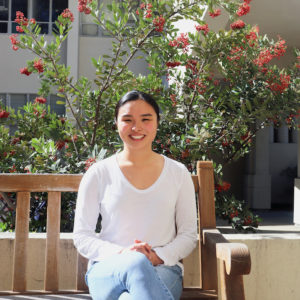
Exercise is medicine, kinesiology professor Marcella Raney ’01 said. For the past 12 years, Raney has led student-research teams to investigate the intersections between kinesiology and public health in Los Angeles. Two student-research teams — one centered on staff wellness and one focusing on green spaces — presented their research at the Southwest American College of Sports Medicine conference in Newport Beach, CA Oct. 25–26.
Riki Eijima (senior) said Occidental’s research differed from other schools at the conference because it was not directly related to sports medicine and athletic performance.
“That’s the direction that sports medicine should be in,” Eijima said. “We can also use our scientific resources to affect change for marginalized groups.”
Research close to home
The staff wellness study was the brainchild of Oliver Artiga ‘19. Artiga proposed a stretching intervention for Occidental’s cleaning staff to Raney in Fall 2018. By Spring 2019, research was underway.
As a part of the staff wellness team, Elaine Cramer (senior) asked hourly staff workers to indicate where they felt pain using a diagram of the human body. The majority of workers circled the upper and lower back, as well as the hands, Cramer said. Over 80 percent of adults experience back pain, but Cramer said it is more prevalent among hourly workers who may not be using correct form when doing repetitive tasks, such as squatting and lifting. The goal of their 10-week study was to decrease this pain, according to Cramer.
Three days a week, before the workers started their shifts at either 7 a.m. or 4 a.m., the student-researcher team led them in a series of flexibility exercises in both English and Spanish. For the group that started at 4 a.m., Cramer said they also gave them functional application exercises — demonstrating the proper form for vacuuming, wiping and picking up trash cans, for example. Raney is a certified exercise physiologist and oversaw the exercises. At the end of their study in the Spring 2019 semester, both groups had increased flexibility and strength and decreased pain.
Cramer did not know Spanish before the research, but she said now she has a vocabulary of highly specific, movement-related words. Despite the language barrier, she said she has made friends with many members of the cleaning staff.
“We always say hello when I see them in the morning,” Cramer said. “[The research] was really great because it showed that we cared. I think a lot of students do care about the workers, but don’t know how to express it, especially if they don’t speak Spanish.”
In Fall 2013, Raney’s previous student-research teams created the website Get Fit Together Los Angeles. The website provides low-income LA residents with fitness, wellness and exercise tips and videos. While the website is user-friendly, not everyone has access to a computer, Eijima said. To make the resources more accessible, students researchers are collaborating with Oxy Open Source to develop a Get Fit Together LA app.

While there are many apps that provide healthy recipes and exercises, Eijima said many are not culturally relevant. People may work multiple jobs and may not be able to work out for a full 30 minutes. Instead of pushing people to go fully vegan, for example, the app suggests feasible diet changes such as pinto beans and brown rice in place of refried beans and white rice.
Research branching out into the community
Raney, along with two of her students, Colette Hendry ’18 and Samantha Yee ’18, was the first to document the positive impact of green spaces at playgrounds over time. Green space is a space where water can be absorbed into the ground, according to Raney. Asphalt is not water-permeable, but pairing it with grass fields creates green space.
The majority of Los Angeles Unified School District (LAUSD) elementary schools are 100 percent asphalt, Raney said. In the summer of 2016, Eagle Rock Elementary School replaced 21,000 square feet of asphalt with green space — an oblong-shaped crossfield flanked with trees, native plants and an outdoor classroom with logs and stumps. Before the asphalt was removed, Raney and her team collected data on student activity and behavior, such as what games they were playing and how students were interacting with each other. After the greening of the schoolyard, they found that more students were exercising and there was a decrease in verbal and physical conflict. They are still in the process of analyzing more data, Raney said.
As part of the Undergraduate Summer Research Center, Elena Daniel (senior) continued Raney’s research at Buchanan Elementary School, looking further into the impact of green space on student behavior. Daniel was selected as one of Occidental’s 2019–20 Science Scholars and received a research grant to fund her research through graduation. She is the first kinesiology major to ever win the award. Daniel’s research will not end after she graduates: she is currently developing protocols for parts of her research that may not be implemented until after she graduates, according to Raney.
“We won’t be starting from ground zero,” Raney said.
Rooted in athletics
Most people in the kinesiology department are either former athletes, current athletes or are interested in the pre-med track, Cramer said. Outside of conducting research with Raney, Cramer is on the swim team, and she is interested in becoming a nurse practitioner.
While a student at Occidental, Raney studied biochemistry and kinesiology and was on both the swimming and diving and track and field teams. She said she enjoys teaching kinesiology because there is a strong connection between what students learn in the classroom and their athletics.
Eijima was a gymnast until she suffered a back injury when she was 12. She credits her physical therapy team for helping her recover and getting her interested in the health care and kinesiology fields.
“Classes in UEP and public-health-related classes make sure I see the big picture,” Eijima said. “Chemistry and biology are so micro, but health is not. Health is macro.”
![]()


































